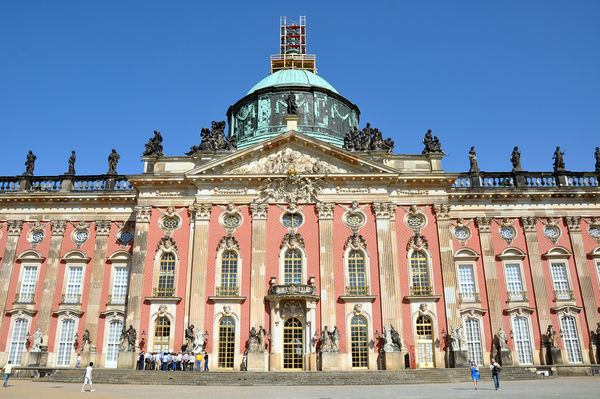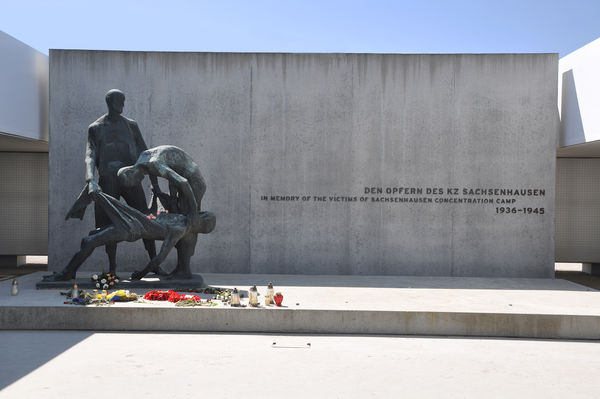Berlin Escapes: Three Easy Day Trips
By Rick Steves

Berliners joke that they don't need to travel anywhere because their city's always changing. And while you could spend weeks in Berlin and not run out of things to do, if you're in town for at least a few days it's worth considering visits to some nearby sights. Recently I tried out three easy day trips from the German capital.
First I spent half a day at Frederick the Great's opulent palace playground at Potsdam. Next, for a small-town experience that packs a huge historical wallop, I headed about an hour south to Wittenberg, where Martin Luther famously nailed his 95 Theses to a church door. And, on the opposite side of Berlin — and the sightseeing spectrum — I made a journey to the Sachsenhausen Memorial and Museum, which commemorates the tens of thousands who died at this concentration camp during the Holocaust.
Potsdam is just half an hour by train from Berlin, but has none of the big city's urban vibe. Squeezed between the Wannsee, one of Berlin's largest lakes, and a lush park strewn with the escapist whimsies of Frederick the Great, it's a sleepy town that has long been Berlin's holiday retreat.
The main sights here are Frederick's palaces: During his reign, Frederick built an ensemble of grand buildings around Sanssouci Park, with the two main palaces located at either end (a 30-minute walk or 10-minute bus ride between them).
While both palaces are impressive, they don't quite crack Europe's top 10 — and visiting both is overkill for most. The small, super-Rococo Sanssouci Palace is the more interesting of the two, and worth seeing for its opulence. But Frederick's massive New Palace is also imposing, especially its two showstopper rooms: the Marble Hall, with its dramatic 52-foot high ceiling, and the Grotto Hall, featuring marble walls encrusted with thousands of seashells, semiprecious stones, and fossils.
Beyond these royal retreats, Potsdam is simply enjoyable — a swanky bedroom community, where, thanks to its aristocratic heritage, everything seems bigger and better than it needs to be. Cold War enthusiasts might focus on the Cecilienhof (site of the famous Potsdam Conference held at the end of World War II) and the nearby KGB Prison Memorial (a museum and documentation center honoring victims of the Soviet spy agency).
In contrast to the royal sights in Potsdam, Wittenberg — my next stop — is a humble small town. You need only look at its official name — Lutherstadt Wittenberg — to know this small city's claim to fame. The adopted hometown of Martin Luther, and the birthplace of his Protestant Reformation, little Wittenberg has a gigantic history that belies its straightforward townscape.
Wittenberg can be a worthwhile stop even for those unfamiliar with the Great Reformer. It has a pair of historic churches — the Town Church of St. Mary, where Luther preached, and the Church of All Saints (Castle Church), where he famously hammered his 95 Theses to the door, challenging the power of the Catholic Church. There's also an excellent museum about Luther's life (Luther House), which displays original artifacts — the pulpit from which Luther preached, portraits of Luther and the other reformers, and the Bible Luther boldly translated from Latin into the people's language.
Literally "White Hill," Wittenberg sits atop a gentle rise above the Elbe River. The city is newly spiffed up and sparkling after recently celebrating the 500th anniversary of the Protestant Reformation. It's also an easy visit. The tourists' Wittenberg is essentially a one-street town — its sights are satisfying and quickly seen in just a few hours.
About 20 miles north of downtown Berlin is another historic site: the Sachsenhausen Memorial and Museum. While it can be a hard and emotional visit, as with all concentration camp memorials, the intention of Sachsenhausen is to share its story and lessons — and prevent this type of brutality from ever happening again.
Sachsenhausen was not, strictly speaking, a "death camp" for mass murder (like Auschwitz); it was a labor camp, intended to wring hard work out of the prisoners. Sachsenhausen's proximity to the capital gave it special status as the place to train camp guards and test "new procedures" — such as horrifying medical experiments on inmates. About 50,000 died here, while countless others were transported elsewhere to be killed.
The camp's exhibits are scattered throughout the grounds in various buildings. You'll learn how Sachsenhausen was built by its prisoners and see original artifacts, including the gallows, a bunk from the barracks, and uniforms. There are also chilling photos, a camp model, and a 22-minute film. Many visitors come away from here with more respect for history — and the dangers of mixing fear, the promise of jobs, blind patriotism, and an evil government.
As one of Europe's top destinations, Berlin welcomes more visitors annually than Rome. Whether it's the opulent palaces of Potsdam, the sweet Luther-laden town of Wittenberg, or the sobering Sachsenhausen Memorial, an escape from the city can be a welcome break from its urban intensity.

